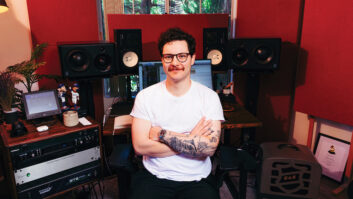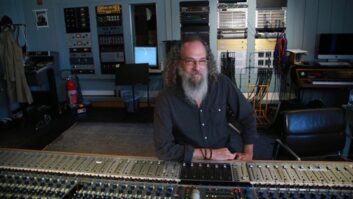Thanks to the Flaming Lips, headphones were on everyone’s minds, and ears, at a San Francisco stop on the Music Against Brain Degeneration Revue tour. The Oklahoma City band passed out 500 headphones and Walkman-style radios to audience members at each stop on their tour in an effort to replicate/enhance the lush ’60s psychedelic sound of their new album, The Soft Bulletin.
“Usually when you go to shows, honestly, the sound is horrible,” says Michael Ivins, bassist for the band known for its boombox sonic experiments and Zareeka (a four-CD release designed to be played simultaneously). “I think it came about when Wayne [Coyne, the Lips vocalist] went to one of those big multiplex theaters where they give you hearing-impaired headphones. You have the sound right there in your ear, and that’s basically the idea. You get all the little nuances that you really do miss live, that you hear on records or in the car or in the house-reverb tails, a little bit of the high intelligibility of the vocals.”
The process is simple. Audience members trade an ID for a set of Megabass MDR-W08 headphones, a radio and a card with instructions. They then tune into a broadcast of the concert’s stereo mix.
Some listeners bring their own “high tech” Sony 75 or 76 headphones, but the headphones you stick right in your ear, that don’t block a lot of exterior sound, actually work better, says FOH engineer Chris Chandler. “With those, you get a lot of stage sound and headphone sound together,” he says. “You don’t lose all the bottom.”
“That’s the idea, enhancing not replacing,” says Ivins.
The headphones seem a good fit for the tour, which Ivins compares to the “old-style Motown revues.” (The tour will resume this winter with a different lineup of bands.) “The whole idea behind Music Against Brain Degeneration is: If you listen to complex music and concentrate on it, it supposedly will help you think better,” he says. “So hopefully you listen to all the complex music that’s going on here and leave the show, if not smarter, at least not dumber than when you came in.
“The headphones really concentrate things. You know, when you’re walking down the street and someone has headphones on, you don’t f-with them,” he says with a laugh. “If you’re in a club and you don’t want to talk to anyone, you just put the headphones on. And you can’t get away from it, it’s right there.”
When the revue rolls into town, tour manager Darryl Bascom finds the biggest gap between stations for broadcast. The signal only extends 100 to 150 yards, and they haven’t had any problems with interference yet.
On the road, Chandler uses the house console but also carries an effects rack with a Lexicon PCM 200 and 41, an SPX900 and a “Big Bottom” effects box. He mixes the music for broadcast down to a “lo-fi” Yamaha 4-track MT120. Chandler and Ivins then broadcast the entire show on a Ramsey SM100 FM transmitter, which the Lips assembled from a kit. The transmitter’s homemade PVC pipe antennas also need to be moved around the venue to avoid buzz.
At the Fillmore in San Francisco, the experiment seemed only partly successful. This audience member could hear more sonic definition, trebly details and some of the panning effects when the Flaming Lips and Sonic Boom’s E.A.R. performed. But the effect was negligible during the more spare sets by Robyn Hitchcock and Sebadoh, and the loud house sound demanded an equally high volume from the radios. As a result, listeners were advised to only use the headphones for 10 minutes at a time, according to the instruction cards passed out with the headsets.
The variety of musical styles seem to offer an engineering challenge, but Chandler says the tour is easy because almost all the bands don’t use live drums. (Sebadoh, which does, has their own engineer, Miles Kennedy.)
Chandler’s main challenge, he says, is getting vocals up over the stage volume. Recently acquired Audix OM5 mics have cut down on bleed from overall stage volume, he explains, “but it’s definitely a chore to get the vocals up without feeding back. So if you want to hear the vocals better, you just put on the headphones.”
“And you can go to the bathroom and not miss the show,” adds Ivins.







